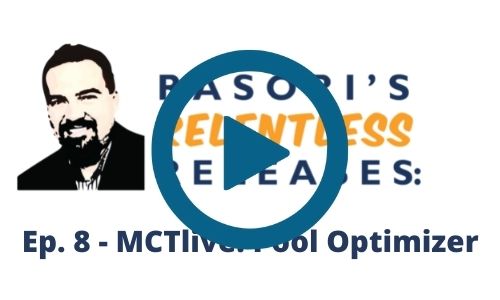
Rasori’s Relentless Releases Episode 8:
Published 3/18/2022
In MCT’s eighth video episode of Rasori’s Relentless Releases, Phil Rasori covers the features of the MCTlive! Pool Optimizer.
View the episode to get the scoop on these timely updates.
MCT® is continually optimizing our capital markets software to keep up with the current market space. In an effort to inform you of these real time enhancements this video will review the latest MCTlive! innovations and functionality updates for your benefit. View the episode then join our newsletter to be updated on new releases.
About the Video:
In Episode 8 of Rasori’s Relentless Releases, Phil Rasori discusses the MCTlive! Pool Optimizer.
Topics Include:
- The unique interface between the MCTlive! Pool Optimizer and the Agile MBS pool bidding tool
- Similarities and differences that exist between agency cash window commitment optimization and pooling optimizations
- MBS pooling optimization beyond Agency cash window commitments
Want to stay updated? Join our newsletter to be notified of future releases.

Rasori’s Relentless Releases focuses on technology updates to MCTlive!, MCT’s award-winning loan pipeline management software.
Features include:
- 100% Cloud-Hosted, Web-Based, Real-Time Functionality
- Multidimensional Pull-Through Analytics
- MCT Marketplace loan trading exchange
- Electronic TBA Trading
- Rapid Commit for Agency Delivery
Video Transcript
Hello and welcome to the eighth episode of our Relentless Release video series
Today we’re excited to show you our newly released unique interface between the MCTlive! Pool Optimizer and the Agile MBS pool bidding tool
When we initially released the Pool Optimizer, we discussed it in the context of agency cash window commitments
However, as the name would suggest, a major use case of the pool optimizer is MBS pooling optimization
I’d like to take about 60 seconds to just review some of the similarities and differences that exist between agency cash window commitment optimization and pooling optimizations
As we discussed in the initial release, the basis for the need for constrained optimization stems from the creation of high balance loans from the 2008 housing and recovery act and the SIFMA rule that followed allowing for these high balance loans to trade in TBAs up to a 10% de minimus limit
This rule creates the possibility that execution should be sacrificed on certain loans in order to expand the denominator of the TBA pool so that high balance loans can be placed inside the TBA trade
This creates the need for constrained optimization since the combinatorial problem of multiple loans against multiple executions will often create the need for millions and in some cases billions of potential outcomes to be compared
Now, as we reviewed in the last release, with an agency cash commitment scenario, we are looking for the optimal combination of note rate ranges and spec execution sacrifices versus high balance to confirming pickup that yield the highest total weighted average price
When we look at the optimization footprint of an MBS pooling example, in addition to the spec sacrifice potential, we need to look at cross coupon execution for quarter and three-quarter note rates
And of course, this is just for government production, the coupon is normally determined by whether or not the net present value of the servicing income eclipses the difference in coupon pricing
These multiple executions now need to be included in the optimization exercise
Now, just to take a step back for a second, with regards to the standard non spec TBA programs, you’ll notice that these coupon driven execution differentials represent a key difference when compared to cash commitment optimization
In the agency cash commitment scenario, we were simply looking to find the combination of note rate ranges that would allow for the largest volume of high balance to conforming conversions
Whereas in the MBS pooling scenario, moving the slotted coupon of the straight TBA production will always come with execution implications
And as such, these adjustments will affect the complexity of the optimization problem
Using a 3.25 note rate on a straight TBA eligible loan as an example, it can go into both the 2.5 and 3 coupons which obviously provides two potential executions for the optimizer to look at
However, if we take that same note rate and look at the potential executions for a low balance pool eligible loan in a best ex population with three other spec pools, we can see that this particular loan has up to eight potential executions
If we consider that we’re only looking at one execution outlet in this given example, yet the loan has up to eight possible executions within that outlet, the substantial combinatorial complexity is easy to see here
Moving over to MCT Live, for those of you pooling you will see that the new Pool Optimizer button will bring up the Optimization API Portal popup which summarizes the current best execution breakdown of the available loans
The Coupon Volume Breakdown table will show the currently slotted coupons for the TBA denominator production, as well as the additional volume that is available with execution sacrifice
On the far right of the table, you’ll see the total potential high balance volume that can be redirected to TBA regardless of execution
And below the coupon table you can see the coupon breakdown of high balance production that we are looking to optimize
And finally, at the bottom in the Available for Sacrifice table, you can see the available spec breakdown
Then, when we click on Send to Optimizer, these loans will all be sent via our API to our optimization server
And once the algorithm has finished, this Optimization Results box will appear
You can see in this top Optimized Production box, that there’s a summary of which loans have changed programs for an improved price and on the right there’s a comparison between the original and optimized pricing
Now, most importantly on this screen you can the summary of loans where execution has been sacrificed in order to expand the denominator to allow for the high balance loans to be optimized to their conforming pool pricing
And, as we discussed in the initial release of the pool optimizer, it is this execution sacrifice that is fundamental to the need for constrained optimization
And again, this type of optimization can’t be run in Excel or on a legacy inhouse platform
In this simple example, you can see at the top of the screen that the algorithm ran 6,000,000 iterations and the process took around 12 seconds
And just a quick comment on speed of the optimizer. While it sits on the fastest server available on AWS, the algorithm’s speed is actually derived from the software that its written in
We use a programming language called Cyphon which compiles Python into the lower-level language of C for faster computation
This allows our algorithm to compute approximately half a million iterations per second. For reference, a 500-unit loan sale spread over multiple coupons, with five spec tranches and a lot of high balance will most likely run about 80 million iterations, which will take around 160 seconds, or 3 minutes to run
And then when we add this the best ex rerun that we need to perform, you should be looking at about 6 to 8 minutes to complete the optimization
So, moving back over to the process, we’re going to click on Send to Pool Translation which brings to a summary of which pools are going to be created, and in turn, either sent directly to the Agile platform, or sent to the Pool Tracker
Now, one quick comment here on our example, is that for purposes of this demo I’ve removed any minimum specified payup security thresholds, whereas in practice your dealers will tell you that you will need either volume or unit minimum to get liquidity in a given spec pool
So, in other words, if we’re looking at the second line item here in the Pool Translation Summary, this $200K spec would not be created and instead it would get grouped into the larger volume $225K spec on the fourth line down
So, we will then click the Send to Pool Tracker button down here, which will take us to the Pool Tracker tab in MCT Live
Now, there’s a lot of functionality in the Pool Tracker that we’re excited about and we’ll definitely have a future release video on this, but for now I just want to review the ability to edit your pool if needed and then submit it to the Agile platform for bidding
So, if we click on the Edit Pool button here, you can see that you have the ability to update security parameters and add or remove loans from the prospective pool
And then in the rare case that you were sending this to a specific broker dealer without best-exing, and thus not using the Agile platform, you have the ability to manually input your trade details as well
But moving back over to the open pool breakdown table, once we’ve got our pool ready to rock here, we’ll click the Submit Pool to Agile button
This will bring us over to the Master Trader Tab in MCT Live and then automatically populate the Agile MBS Pool Bidding tool
Now, there’s obviously a lot of information on this screen on this popup and we’re going to have a future release where our head trader, and creator of this tool, Andrew Rhodes, will review the functionality in detail and walk us through the entire BWIC process using the Agile platform
But for now, you can see that all the security parameters auto populate and your BWIC dealer list is automatically selected and ready to go as well on the left
And it’s this three-legged integration from best ex analysis to Pool Tracker and finally to the Agile MBS Pooling platform, that is the basis for our excitement about this release
We’ve gone from a list of ready for sale loans to a set of fully optimized pools, out for bid, in less than five clicks
That brings us to the end of our demo, I appreciate your time and looking forward to our next release.
Thank you

“The combinatorial problem of multiple loans against multiple executions will often create the need for millions and in some cases billions of potential outcomes to be compared.”
Phil Rasori, COO, MCT
About the Host:
Phil Rasori, Chief Operating Officer, MCT
Mr. Rasori is a recognized thought-leader in capital markets operations within the mortgage banking community. His areas of expertise include complex financial modeling, computational dynamics, and linear programming for operational optimization. He developed the ground-breaking mortgage pipeline hedging algorithms that form the foundation of MCT’s HALO Program today. He has also pioneered several metrics that have become standard industry parlance, including “beta pull-through” factors. In addition to banking clients, Mr. Rasori has consulted with GSE agencies and the US Government on hedging best practices for community banks. Mr. Rasori has functionally led MCT operations since 2005 and ascended to his current role as COO in 2007.
Mr. Rasori is a graduate of University of California, San Diego, and holds a B.S. in Management Science.




